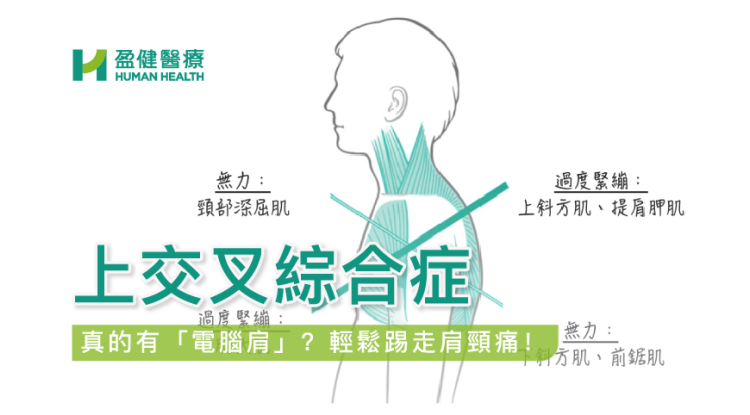Upper Crossed Syndrome

Is “Computer Shoulder” Real?! - Upper Crossed Syndrome
Lately, the term “computer shoulder” frequently appears in TV ads, but does this condition really exist?
For those working long hours from 9 to 5 plus overtime, long periods of computer use combined with poor posture often lead to neck and shoulder pain and muscle tension. Studies find that about 60% of computer users experience shoulder or neck discomfort. However, medically speaking, there is no such condition as “computer shoulder.” What advertisements refer to is most likely Upper Crossed Syndrome (UCS).
When sitting in front of a computer monitor for long hours, it is natural to extend your neck, hunch your back, and even raise your shoulders. Typical signs include:
This poor posture not only makes you appear less confident but causes severe muscle pain in the shoulders and neck, making simple actions like looking up or raising your hands uncomfortable. Over time, it may even accelerate cervical spine degeneration.
How to Prevent Neck and Shoulder Discomfort?
Try these tips to reduce computer-related shoulder and neck discomfort and help overcome Upper Crossed Syndrome:
TIPS 1: Start with Improving Your Posture
According to Harvard University, posture improvement is crucial. Make an effort to strengthen the weaker muscles mentioned earlier:
-
Pull your chin back – activate deep neck muscles
-
Keep your chest out and spine straight – engage lower back muscles
Remember to keep shoulders relaxed. Rest your arms on the desk or chair armrests to reduce shoulder strain. Maintaining this good posture consistently can make shoulder or neck pain much less likely!
TIPS 2: Adapt Your Environment
-
Harvard also warns that improper monitor height, causing the neck to jut forward, can cause muscle strain or even damage to cervical vertebrae, nerves, and intervertebral discs.
-
Check your monitor position—its top should be level with your eyes.
-
Support your lumbar spine using cushions or chairs with lumbar support to prevent slouching and help maintain chest posture, improving UCS symptoms.
TIPS 3: Take Regular Breaks and Move
Even with good posture and an optimized workspace, prolonged computer use strains your shoulders and neck.
-
Change position every 15 minutes. Get up, drink water, walk to the restroom to give your shoulders and neck a break.
-
Perform simple exercises to relax your muscles:
-
Shoulder and neck stretches: 10 reps per side, hold each for 10 seconds
-
Chest stretches: open arms wide, hold for 10 seconds
-
Strengthen deep neck muscles
-
Strengthen shoulder blades and back muscles: use water bottles as dumbbells, pull hands backward, hold 5 seconds, 10 reps
-
Follow these three tips, and Upper Crossed Syndrome will become a thing of the past!
Hong Kong Registered Physiotherapist
The information on this website is for educational purposes only.
You should consult your doctor regarding surgical methods and not solely rely on this website’s information.




